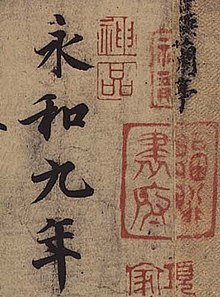Orchid pavilion
Orchid Pavilion ( Chinese 蘭亭 序 , Pinyin Lántíng xù ) is the title of the most famous Chinese calligraphy by Wang Xizhi . It was made in the late spring of 353. On that day, Wang Xizhi and his friends met at the orchid pavilion (lántíng) in Kuaiji ( Chinese 會稽 , Pinyin Kuàijī ) to poetry and drink.
The scholars sat down on the bank of a stream and put wine bowls in the water. Whoever they stopped in front of had to write a poem. On this occasion, Wang Xizhi wrote the " Foreword to the gathering at the Orchid Pavilion " ( Chinese 蘭亭 集 序 , Pinyin lántíng jí xù ).
In the evening, the society decided that each participant should write a poem to commemorate the meeting. Sixteen of them were so drunk that their paper was left blank. Wang Xianzhi , Wang Xizhi's son, could only write his name down.
Wang Xizhi wrote his poem and added an afterword with which he created his masterpiece. He considered these twenty-eight lines to be his most beautiful calligraphy until the end of his life.
The Lanting Xu consists of 324 characters in 28 lines. The character zhī ( 之 ) appears 20 times, but no two of these characters look alike.
The fact that the emperor of the Tang Dynasty , Tang Taizong had himself buried with the Lanting Xu , proves how great the admiration for this document was .
Original text

English translation in Wikisource :
